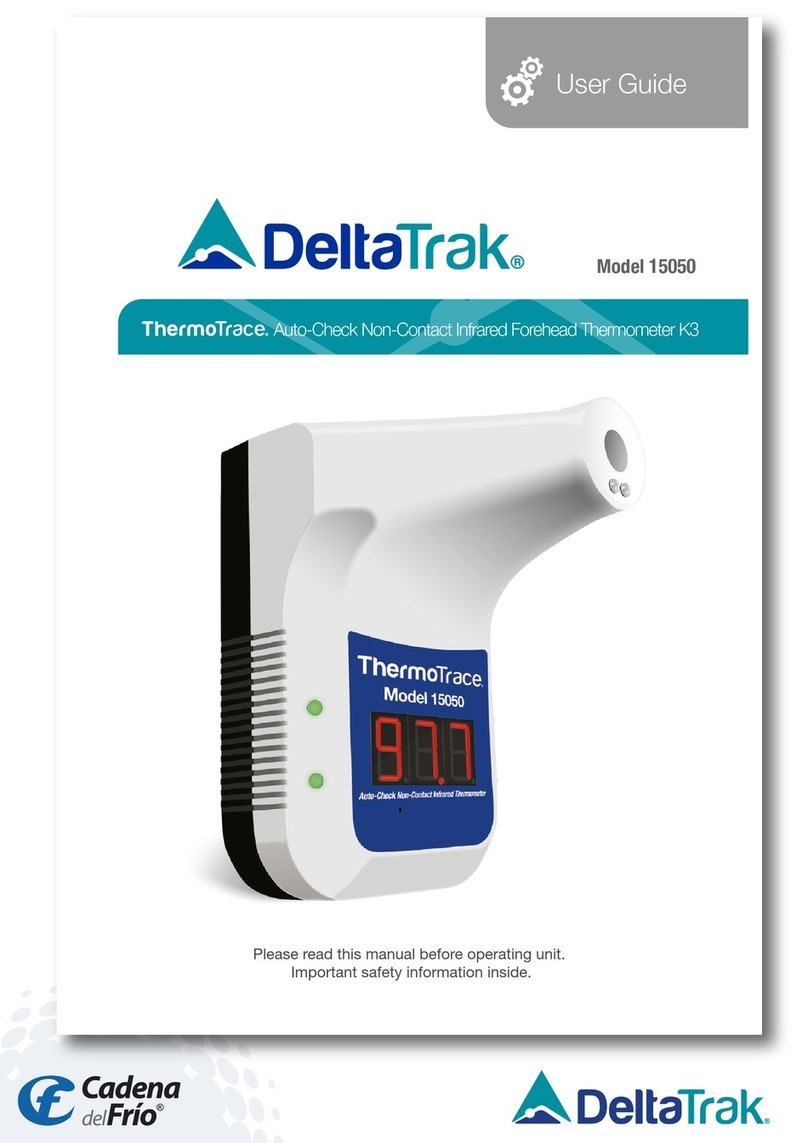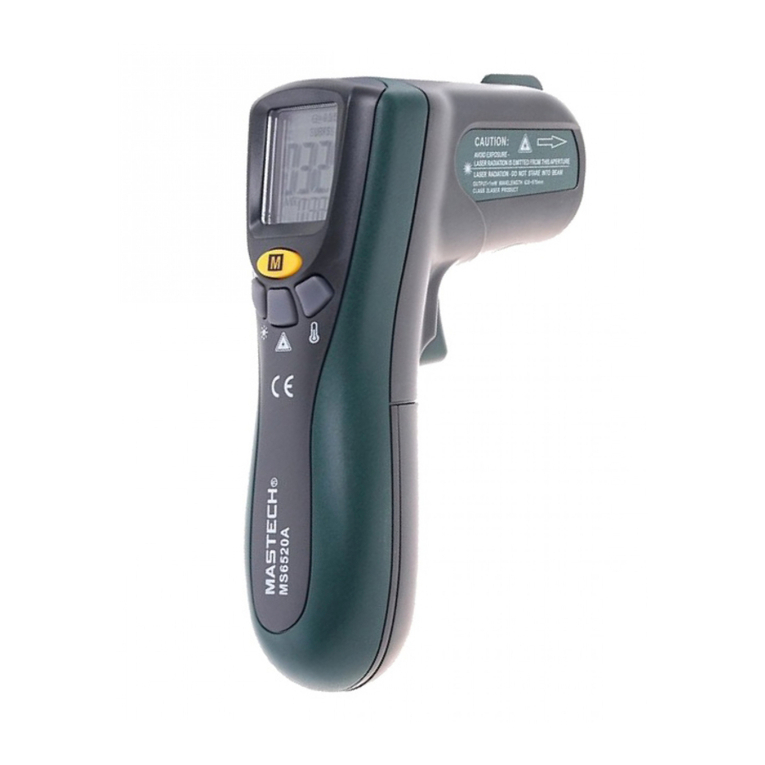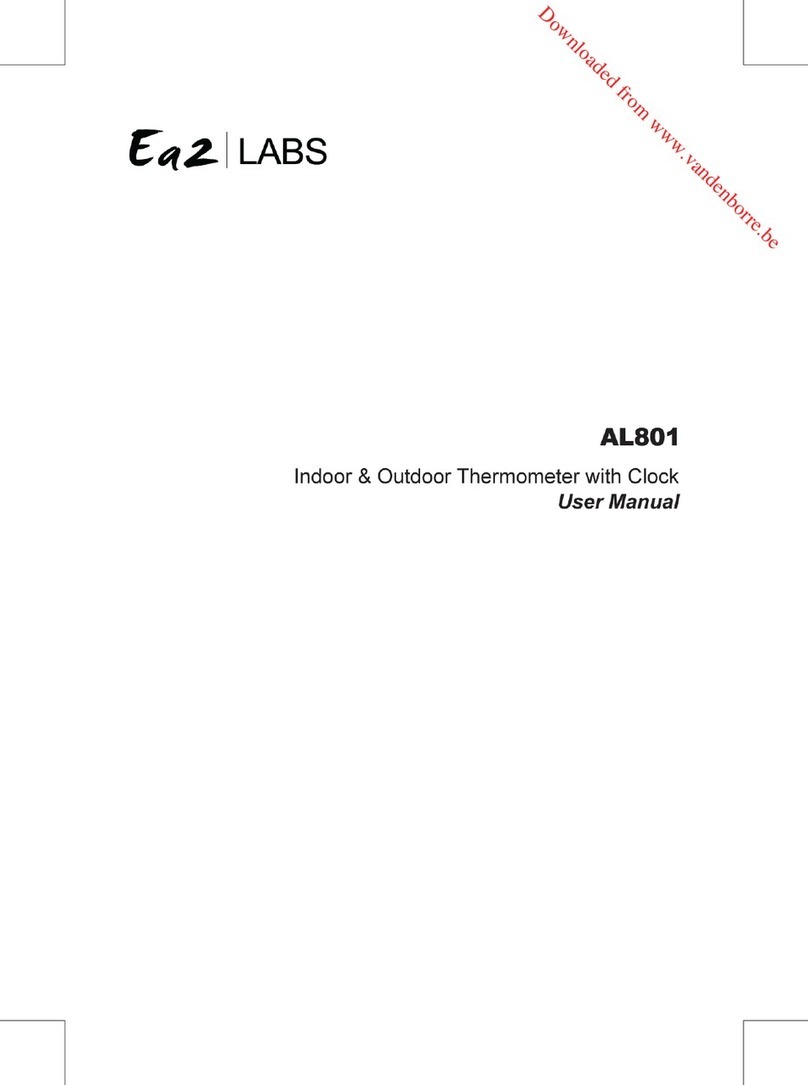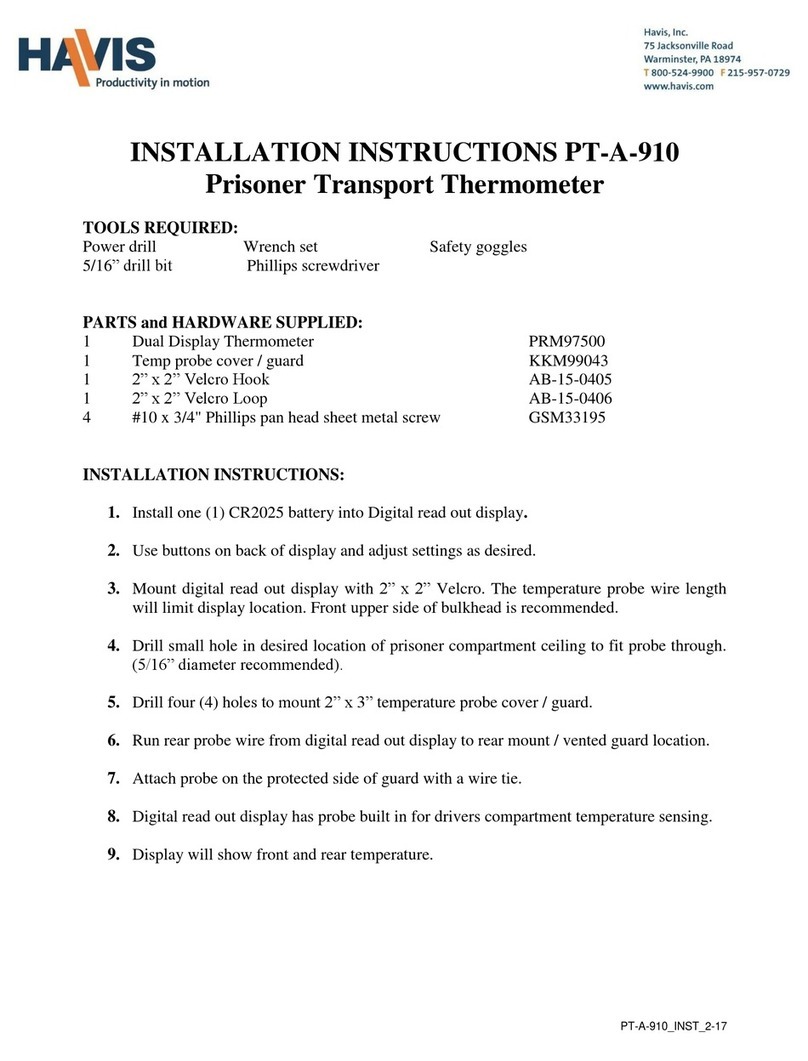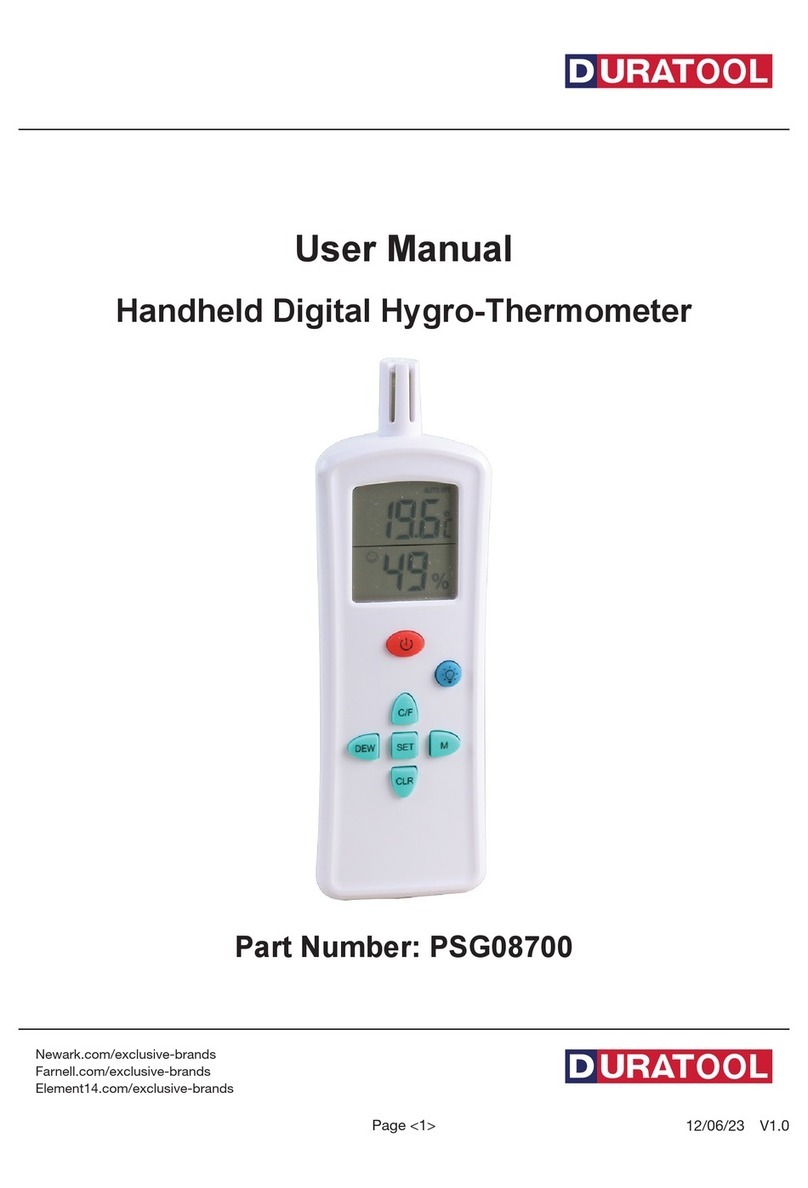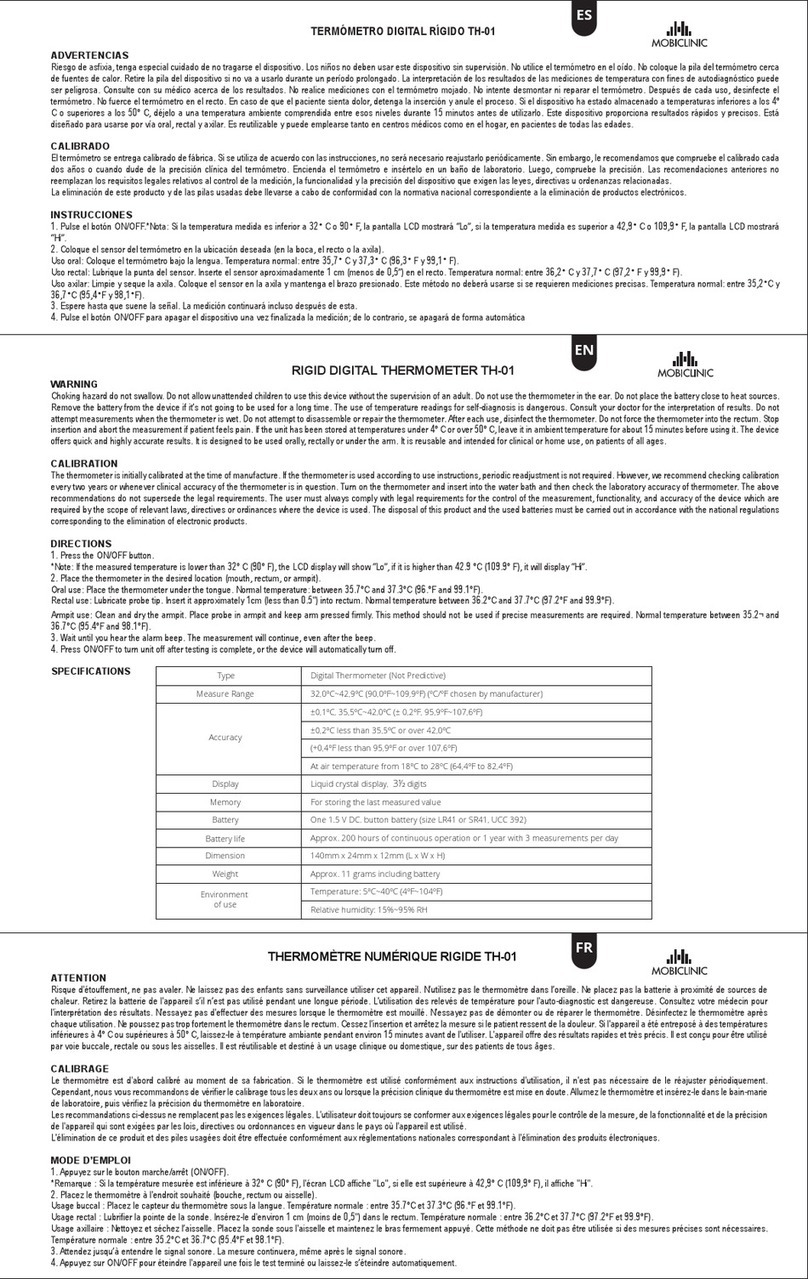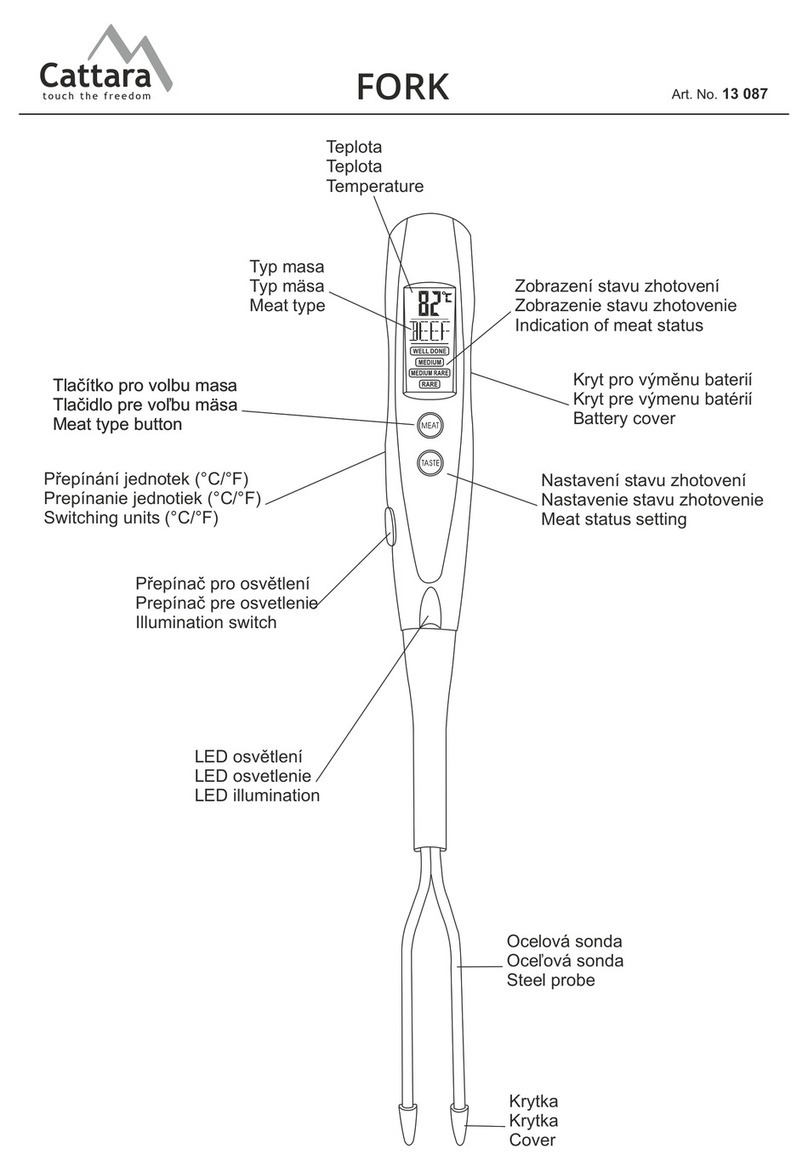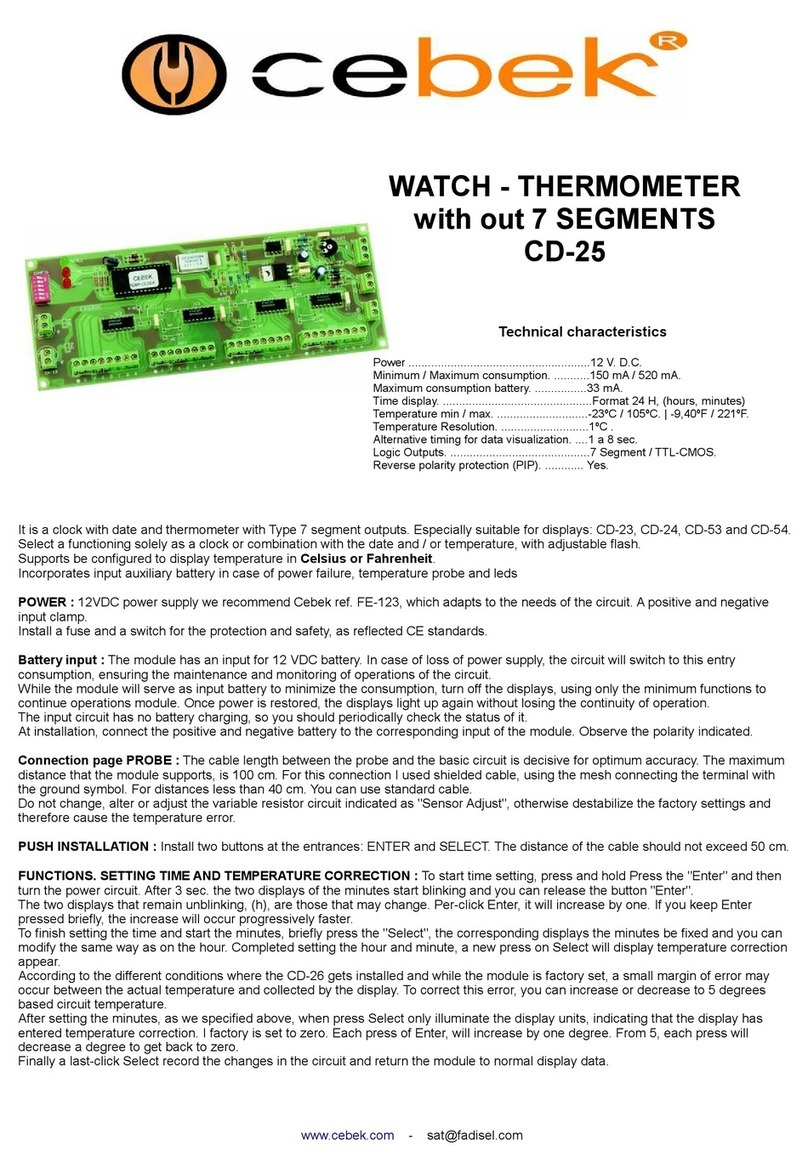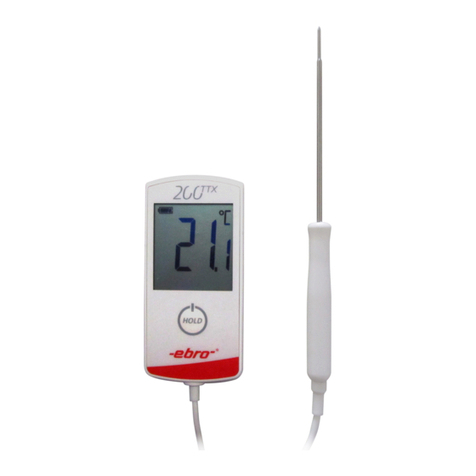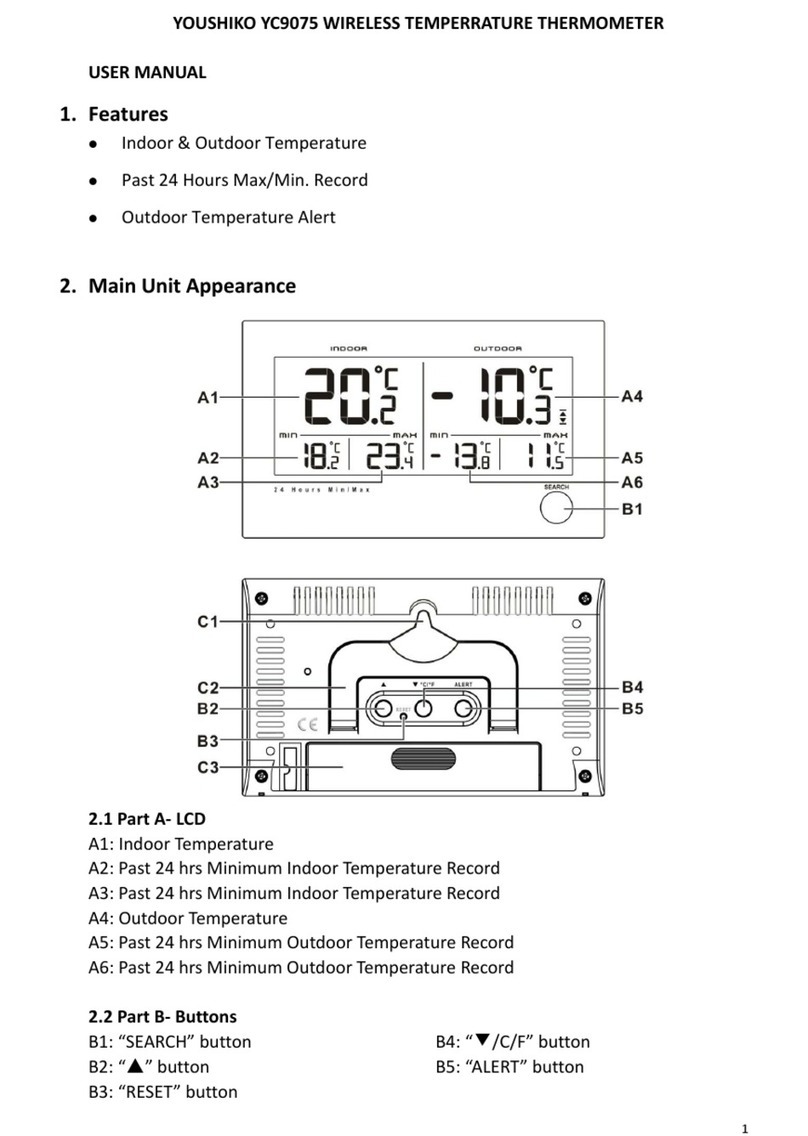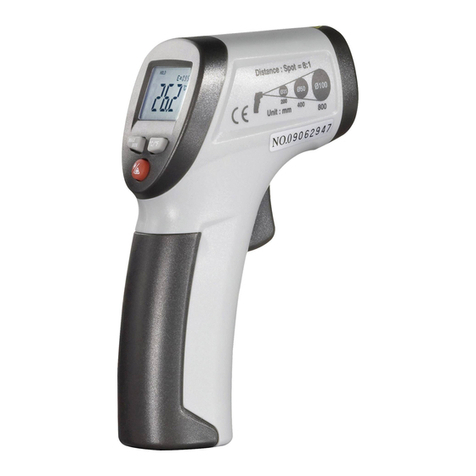DeltaTRAK CK-T1501 User manual

User Guide
Non-Contact Forehead Infrared Thermometer CK-T1501
Model 15045
Please read this manual before operating unit.
Important safety information inside.

1
Product Introduction and Classification .........................................................1
Operating Principle......................................................................................2
Product Features ........................................................................................3
Updated Features .......................................................................................3
Structure and Composition ..........................................................................3
Technical Parameters ..................................................................................4
Configuration ..............................................................................................5
LCD Screen Indicators .............................................................................5
Setting Operation........................................................................................6
Measurement Mode ......................................................................................... 6
F1: Temperature Scale...................................................................................... 7
F2: Temperature Alarm ..................................................................................... 7
F3: Temperature Calibration ......................................................................7
F4: Buzzer ..............................................................................................7
Temperature Calibration Method...................................................................8
Helpful Tips for Reliable Results....................................................................8
Instructions for Taking Body Temperature....................................................10
Instructions for Taking Surface (Object) Temperature ....................................11
Replacing the Batteries..............................................................................11
Maintenance and Cleaning.........................................................................12
Troubleshooting ........................................................................................13
Warranty ..................................................................................................13
Contents
1. Product Introduction and Classification
The Non-Contact Forehead Infrared Thermometer measures body
temperature using the infrared thermal radiation from the human forehead.
Its operation is simple and sanitary, fast and accurate. This device quickly
and accurately measures body temperature. Point the device at the
forehead and press the measurement trigger. It is widely used in schools,
hospitals, homes and customs. The patient is the intended user of this
product and can measure temperature, change battery, and maintain
device and accessories according to user manual.
The materials (ABS) which come into contact with the patient have passed
the ISO 10993-5 and ISO 10993-10 standards tests and no toxicity, allergy
or irritation was identified. The device is compliant with MDD requirements.
Based on the current science and technology, other potential allergic
reactions are unknown.
This device can be used to measure temperature of objects between 0°C
and 118°C. It is widely used in the agriculture industry, food, petrochemical

2
Explanation of Symbols
!Symbol for “General warning sign” Symbol for “This way up”
SN
Symbol for “Serial number” Symbol for “Keep dry from rain”
LOT
Symbol for “Batch code” 0598 Symbol for “CE mark”
Symbol for “Manufacturer” Symbol for “Date of manufacture”
Symbol for “The operation guide must be read”
Symbol for “Fragile, handle with care”
Symbol for “Non-ionizing electromagnetic radiation”
Symbol for “This marking shown on the product or its literature,indicates that it should
not be disposed of, with other household waste at the end of its working life. To
prevent possible harm to the environment or human health from uncontrolled waste
disposal, please separate this from other types of waste and recycle it responsibly to
promote the sustainable reuse of material resources.”
and other industries. Not intended for use in the emergency medical
services environment.
This device is a Type B applied part. It is a European Union Class II device
and has an International Protection Code of IP22. (The first 2 indicates the
device is protected against solid foreign objects of 12.5 mm in diameter
and greater. The second 2 indicates the device is protected against
vertically falling water drops when enclosure is tilted up to 15°. Vertically
falling water drops shall have no harmful effects when the enclosure is titled
at any angle up to 15° on either side.)
Do not use this device for continuous temperature monitoring purposes.
Do not use this device in an environment where flammable anesthetic
mixture with air or with oxygen or nitrous oxide is available. There are no
contraindications.
The CLINICAL BIAS, cb=-0.17,
With its LIMITS OF AGREEMENT, LA=0.46,
The CLINICAL REPEATABILITY, r=0.15
2. Operating Principle
All objects, solid, liquid or gas emit energy by radiation. The intensity of this energy
depends on the temperature of the object. The Non-Contact Forehead Infrared
Thermometer works by detecting the radiation energy being emitted by the arterial
blood flow in the forehead which is in close proximity to the heart and runs just
below the skin surface. When the radiation sensor of the thermometer is activated,
the forehead temperature measurement is taken by detecting the infrared heat
generated by the arterial blood flow.

3
Body
°C
Body
°C
Body
°C
• Precision infrared sensor
• Quickly acclimates to ambient temperature
• Proprietary probe design to ensure more accurate measurements
• Two measurement modes (Body/Object) with convenient and practical
mode selection switch
• High temperature alarm
• Automatically saves last measurement value
• Large LCD Screen
• Bright white backlight
• Selectable °C/°F
• Automatic power save
3. Product Features
4. Updated Features
This product consists of an infrared sensor, microprocessor, memory,
power supply, electro-acoustic components, LCD screen, and enclosure.
5. Structure and Composition
Normal
Temperature Display
32°C - 37.5°C
(89.6°F - 99.5°F)
Slightly Higher
Temperature Display
37.6°C - 37.9°C
(99.7°F - 100.2°F)
Fever
Temperature Display
38.0°C - 42.5°C
(100.4°F - 108.5°F)

4
6. Technical Parameters
Measuring Method Non-Contact
Measuring Distance 3cm - 5cm (1.2in - 1.9in)
Measuring Range 32°C - 42.5°C (89.6°F – 108.5°F)
Tolerance Scope ±0.2°C (Within 35°C - 42°C) (±0.36°F)
±0.3°C (Out of range 35°C - 42°C)
Display Resolution 0.1°C (O.1°F)
Operation Conditions
Temperature 10°C - 40°C (50°F - 104°F)
Relative Humidity 15% - 85% (Non-Condensing)
Atmospheric Pressure 80kPa - 106kPa
Transport and Storage
Conditions
Temperature 0°C - 50°C (32°F - 122°F)
Relative Humidity ≤90% (Non-Condensing)
Atmospheric Pressure 80kPa - 106kPa
Adjusted Mode Body Mode
(Measuring Site: Forehead; Reference Body Site: Armpit)
Direct Mode Surface Mode
Clinical Bias cb -0.3
Clinical Repeatability 0.08
Limits of Agreement LA0.28
Measuring Time 0.5 Second
Memory 32 Readings
Temperature Scale Celsius or Fahrenheit
Backlight High Brightness Backlight
Battery Indicator Battery Symbol Displayed When Low
Power DC 3V (2 AA batteries)
Auto Shut-Off 15 Seconds
Size 149mm L x 77mm W x 43mm H
(5.9in L x 3in W x 1.7in H)
Weight 172g (6oz) (Without Batteries)

5
7. Configuration
1. Infrared Probe
2. LCD Screen
3. Mode Selection Switch
4. Down Button
5. Up Button
6. Set Button
7. Measurement Trigger
8. Battery Compartment Cover
1. Surface Scanning Mode
2. Body Scanning Mode
3. Temperature Reading
4. Battery Symbol
(displayed when low)
5. Memory Log Number
6. Stored Readings
7. Temperature Scale (°C/°F)
8. Buzzer Symbol (displayed
when on)
LCD Screen Indicators

6
The following settings may be adjusted using the Function menu:
Temperature Scale (°C/°F), Temperature Alarm, Temperature Calibration
and Buzzer. See the table below for more information.
8. Setting Operation
Measurement Mode
• The LCD screen displays the current Measuring mode. (Figure 8.1)
• Slide the Mode Selection switch to select the new Measuring mode.
(Figure 8.2)
• The new mode will take effect immediately.
Notes:
• When in Object mode, the LCD screen will display Surface temp.
• The Object mode measures forehead surface or surface of an object.
It does not measure core body temperature.
Menu Function “-” Key “+” Key Default Note
F1 Temperature
Scale °C °F °C
F2 Temperature
Alarm
Decrease
0.1°C
Increase
0.1°C 38°C Range
37°C – 42°C
F3 Temperature
Calibration
Decrease
0.1°C
Increase
0.1°C 0.0°C Range
-3°C – +3°C
F4 Buzzer OFF ON ON
(Figure 8.1) (Figure 8.2)

7
F2: Temperature Alarm
• Press the Set button for 2 seconds.
• The screen will display F1.
• Press the Set button again to display F2.
• Press the “+” button to increase the temperature.
• Press the “-” button to decrease the temperature.
• Note: The alarm default is 38°C (100.4°F).
F3: Temperature Calibration
• Press the Set button for 2 seconds.
• The screen will display F1 (Figure 8.3).
• Press the Set button twice to display F3.
• Press “+” button to increase the temperature. Press the “-” button to reduce
the temperature.
• Note: The alarm default is 38°C. (100.4°F)
F4: Activating the Buzzer
• Press the Set button for 2 seconds.
• The screen will display F1.
• Press the Set button 5 times.
• The screen will display F4.
• Press the “+” button to turn on the Buzzer.
• “On” will appear on the screen.
• Press the “-” button to turn off the Buzzer.
F1: Temperature Scale
• Press the Set button for 2 seconds.
• The screen will show F1. (Figure 8.3)
• Press “+” button to select °C (Figure 8.4) or “-” button to select °F. (Figure 8.5)
(Figure 8.3) (Figure 8.4) (Figure 8.5)

8
Modify Settings
To modify a setting, press the Set button until the appropriate menu is
displayed and follow the instructions above.
• To calibrate the Non-Contact Infrared Forehead Thermometer, first
take the subject’s temperature with a CLINICAL THERMOMETER.
The result will be 36.5°C (99.5°F), for example.
• Take the temperature of the same individual using the Non-Contact
Infrared Forehead Thermometer. Maintaining a distance of 3 to
5cm (1.18 to 1.97in), aim the device at the forehead. Press the
measurement trigger to take the temperature. Be sure to remove
any obstacles which could alter the measurement, such as hair,
perspiration, cosmetics, etc.
• If the result is the same as the CLINICAL THERMOMETER, the Non-
Contact Forehead Infrared Thermometer is properly set and ready to
use.
• If the result is NOT the same as the CLINICAL THERMOMETER,
adjust the temperature on The Non-Contact Infrared Forehead
Thermometer, by subtracting or adding degree points as
appropriate, using the instructions for Temperature Calibration.
• The offset range is -3°C to +3°C. The factory setting is 0.0°C.
9. Temperature Calibration Method
10. Helpful Tips for Reliable Results
• Prior to use, become familiar with the device.
• Avoid extreme ambient/room temperature.
• Wait at least five minutes before measuring an object when moving
to a new environment.
• When the ambient temperature changes significantly (such as from
indoors to outdoors, equal to or more than 10 degrees), wait 30
minutes before taking temperature measurement.
• Wait 30 minutes after exercising or bathing before taking
temperature.
• Remove hair, sweat, cosmetics and clothing from forehead before

9
(Figure 10.1) (Figure 10.2)
taking temperature.
• When used outside the appropriate operating environment, the
temperature reading may be inaccurate.
• The device measures the surface temperature of an object. It does not
measure the core temperature.
• To prevent injury, be aware that the actual temperature of an object is
much higher than the measurement given by the infrared non-contact
thermometer.
• When the LCD displays “HI”, the measurement exceeds the normal
temperature range. This applies to body temperature higher than
42.5°C (108°F) and object temperature of 60°C (140°F). (Figure 10.1)
• When the LCD displays “Lo”, the measurement is below the normal
range. This applies to body temperature lower than 32°C (90°F) and
object temperature below 0°C (32°F). (Figure 10.2)

10
• Ensure Body Mode is indicated on the LCD screen.
• Point the thermometer probe at the middle of the subject’s forehead
from a distance of 3 to 5cm (1.18 to 1.97in). (Figure 11.1)
• Press the Measurement trigger.
• The measurement will be displayed on the screen in one second.
(Figure 11.2)
• If the temperature is higher than the alarm setting, a tone will sound.
• Extreme ambient temperatures can influence the forehead temperature.
In this event, temperature may also be taken behind the ear. (Figure
11.3)
11. Instructions for Taking Body Temperature
(Figure 11.1)
(Figure 11.2)
(Figure 11.3)

11
• To take surface/object temperature, switch device to Object mode.
• From a distance of 3 – 5cm (1.18 – 1.97in), holding the device vertically,
point it at the surface/object.
• Press the Measurement trigger.
• The device will “beep” and the surface/object temperature will display on
the LCD screen. (Figure 12.1)
12. Instructions for Taking Surface (Object) Temperature
(Figure 12.1)
• When the LCD displays , the batteries are depleted and should be
replaced.
• To replace batteries, open the battery cover and remove old batteries.
(Follow local regulations for disposing.)
• Insert new batteries, observing the correct polarity. A mistake could
damage the apparatus and compromise the device warranty.
• Wait 10-15 minutes after replacing batteries for the device to acclimate
to the ambient temperature.
• Never use rechargeable batteries. Only use disposable AA batteries.
• Remove batteries when the device will not be used for an extended
period, to prevent battery leakage causing damage to the device.
• Do not mix old and new batteries, or batteries of a different type.
13. Replacing the Batteries

12
• Always clean the sensor and the area around the probe to prevent issues
with measurement accuracy.
• Wipe dirt with a clean soft cloth or cotton swab moistened with Isopropyl
alcohol or water.
• Do not expose the device to water.
• Do not disassemble or modify device.
• Do not place the device in extremely low or high temperature for extended
period.
• Do not drop or strike the device.
• Do not hit with sharp object.
• Do not use in sunlight or water.
• Do not use device where there is strong electromagnetic interference.
• Keep away from children.
• Use of this device does not replace physician consultation.
• Do not change the factory settings.
• When device is inoperable, follow local regulations for disposal of device,
battery, packing and accessories.
• Contact retailer or manufacturer for repair. Do not open or attempt to
repair device.
• If device is dropped performance may decline. Contact retailer for
assistance.
• Do not allow heat or cold producing devices to touch thermometer, such
as electric blankets or ice packs. Performance may be impaired and
patient may be injured.
• Allow device to acclimate at least 30 minutes when not in use for long
periods.
• Wireless communications equipment such as wireless home network
devices, mobile phones, cordless phones (and phone bases), and walkie-
talkies can affect the device. The device should be kept at an appropriate
distance, based on the 800 MHz to 2.5 GHz column of Table 6 of IEC
60601-1-2:2007.
• Do not use the device if it is damaged in any way.
• The device should be kept out of reach of children and pets to avoid
inhalation and swallowing of small parts.
• When not in use, store device in a dry room, protected from extreme
moisture, heat, lint, dust and direct sunlight. Never place heavy objects on
storage case.
14. Maintenance and Cleaning
12. Instructions for Taking Surface (Object) Temperature
13. Replacing the Batteries

13
Contact Tech Support at:
Phone: 925-249-2250 Ext 5120 Toll Free: 800-390-0804
The Non-Contact Forehead Infrared Thermometer has a limited warranty
period of 1 year from the date of purchase against defects in material
and workmanship.
16. Warranty
Problem Solution
The screen displays “Hi”
1. Ensure there is no sweat, hair, cosmetics or clothing
covering the forehead. Do not measure temperature
immediately following hot bath, sun exposure or when
hot air is blowing.
2. The device may need to be calibrated. Ensure
temperature offset setting is greater than 0. The factory
setting is 0.0.
3. Check the operating environment. If the device was
used in a very high ambient temperature and then
measured a very low temperature object, allow device
to remain in a mild environment for 10 minutes and
repeat measurement.
4. The temperature reading exceeds the upper limit of
the normal temperature range.
The screen displays “Lo”
1. Ensure there is no cosmetics covering the forehead.
Do not measure temperature immediately after a cold
bath or when there is cold wind or air blowing.
2. The device may need to be calibrated. Ensure
temperature offset setting is less than 0. The factory
setting is 0.0.
3. Check the operating environment. If the ambient
temperature changes too much or the device measures
a low temperature object and immediately measures
a high-temperature object, allow it to remain in a mild
environment for 10 minutes, then repeat measurement.
4. Ensure measurement distance is 3cm to 5cm.
5. The temperature reading is less than the lower limit of
the normal temperature range.
The buttons do not respond 1. Reinstall or install new batteries.
2. Review setting/operation instructions.
There is no display or an
abnormal display Reinstall or install new batteries.
Alarm does not sound Ensure buzzer is set to “ON”.
The device shuts down
immediately after starting Check the battery power; install new batteries.
15. Troubleshooting

14
15. Troubleshooting
©2020 DeltaTrak,Inc.
“CK-T1501”
“CK-T1501”
“CK-T1501”
“CK-T1501”

5528_20G4
P.O. Box 398 Pleasanton CA 94566
(925) 249-2250 (800) 962-6776
www.deltatrak.com
DeltaTrak Corporate
Guadalajara, Mexico
+52-33-3188-3161 / 36712190
www.deltatrakmexico.com
DTI Mexico International
Shenzhen China
+86-755-8442-9388/2837-2741
2837-2664 | 8923-2778
www.deltatrakchina.com.cn
DTI China Limited
NT, Hong Kong
+852-3568-5538
www.dtiap.com
DTI Asia Pacific
Auckland, New Zealand
+64 9 5757 886
www.deltatraksouthpacific.com
DTI South Pacific
Osaka, Japan
+81-6-6616-5900
www.dtijapan.co.jp
DTI Japan Limited
Antwerp Belgium
+32 (0) 3-455-61-25
www.deltatrakeurope.be
DTI Europe bvba
DTI South America SA
Santiago, Chile
+562 2758 2866
+569 7477 1061
www.deltatraksouthamerica.com
This manual suits for next models
1
Table of contents
Other DeltaTRAK Thermometer manuals
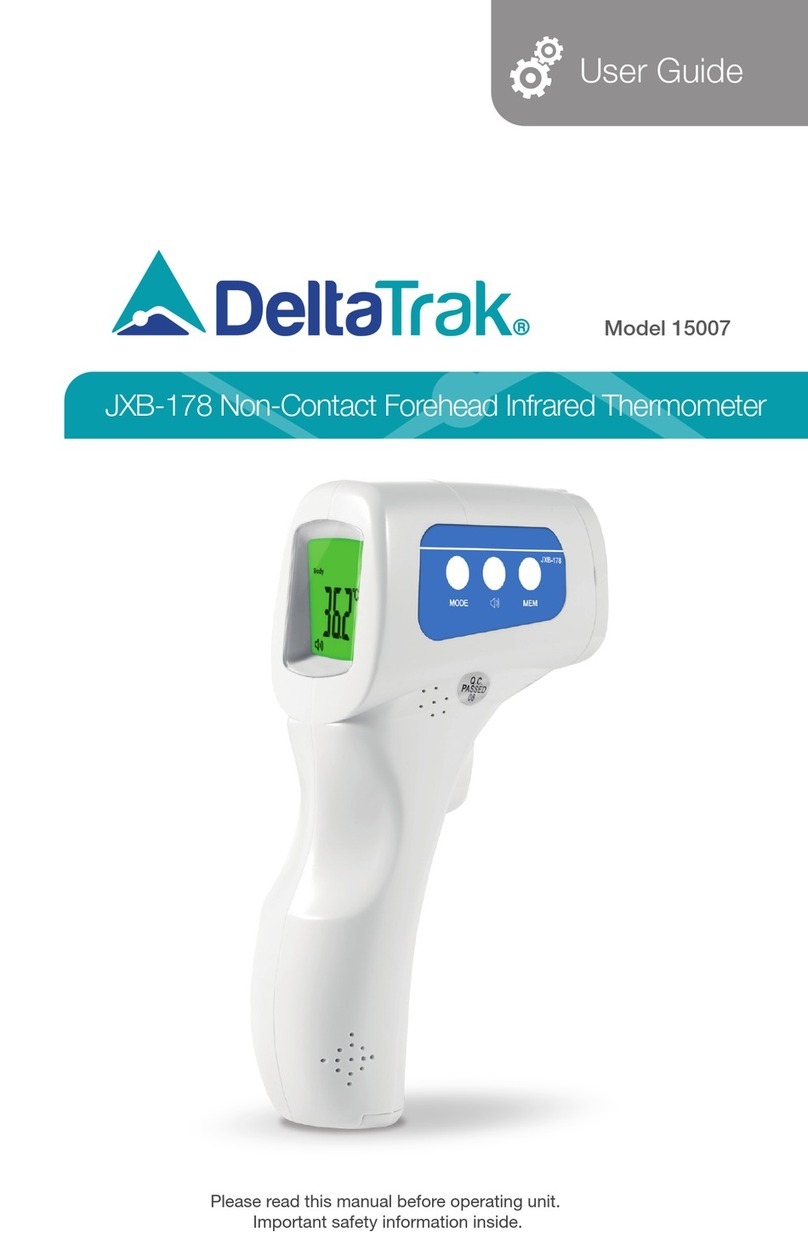
DeltaTRAK
DeltaTRAK JXB-178 User manual
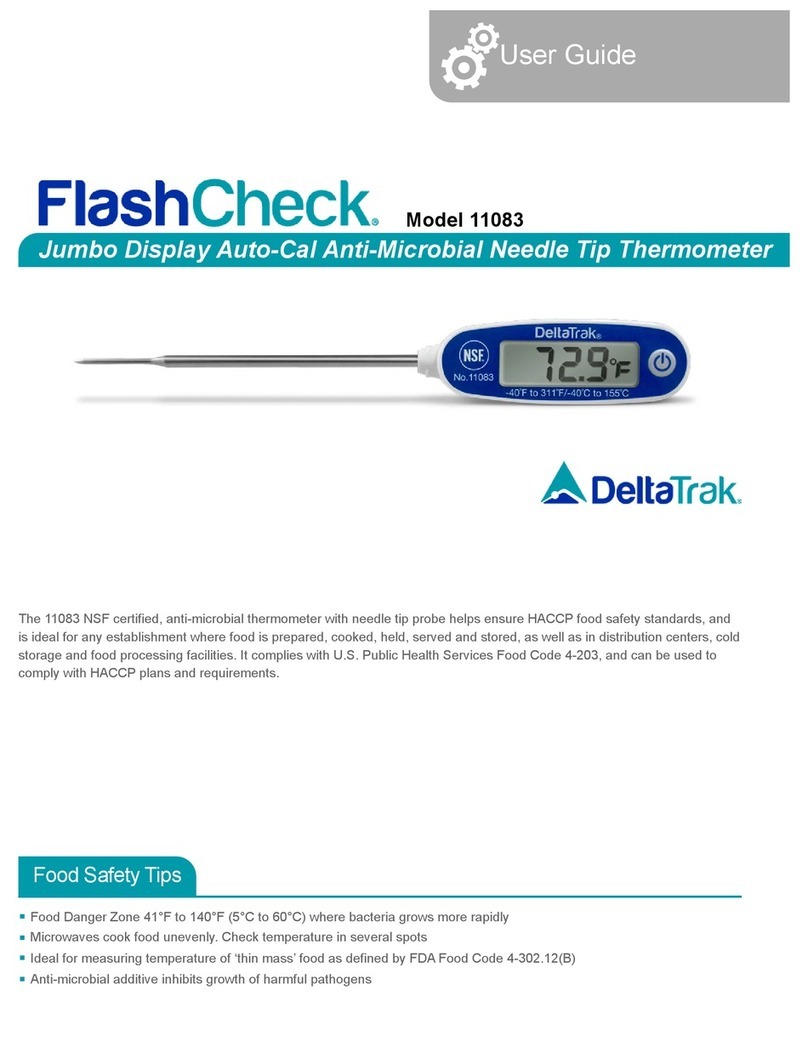
DeltaTRAK
DeltaTRAK FlashCheck 11083 User manual
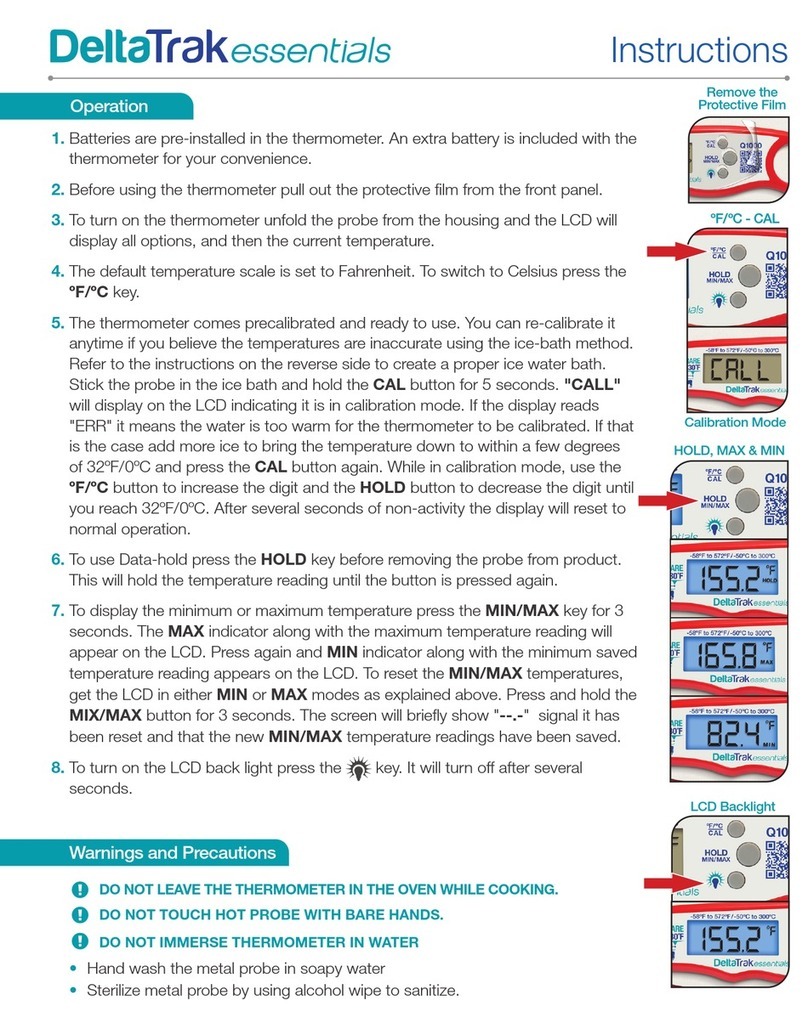
DeltaTRAK
DeltaTRAK Essentials Q1000 User manual

DeltaTRAK
DeltaTRAK ThermoTrace 15039 User manual
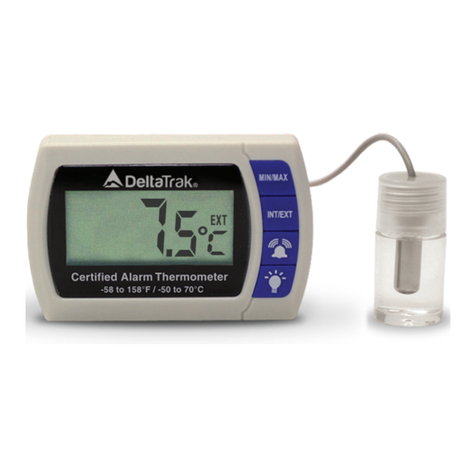
DeltaTRAK
DeltaTRAK FlashLink 12215 User manual
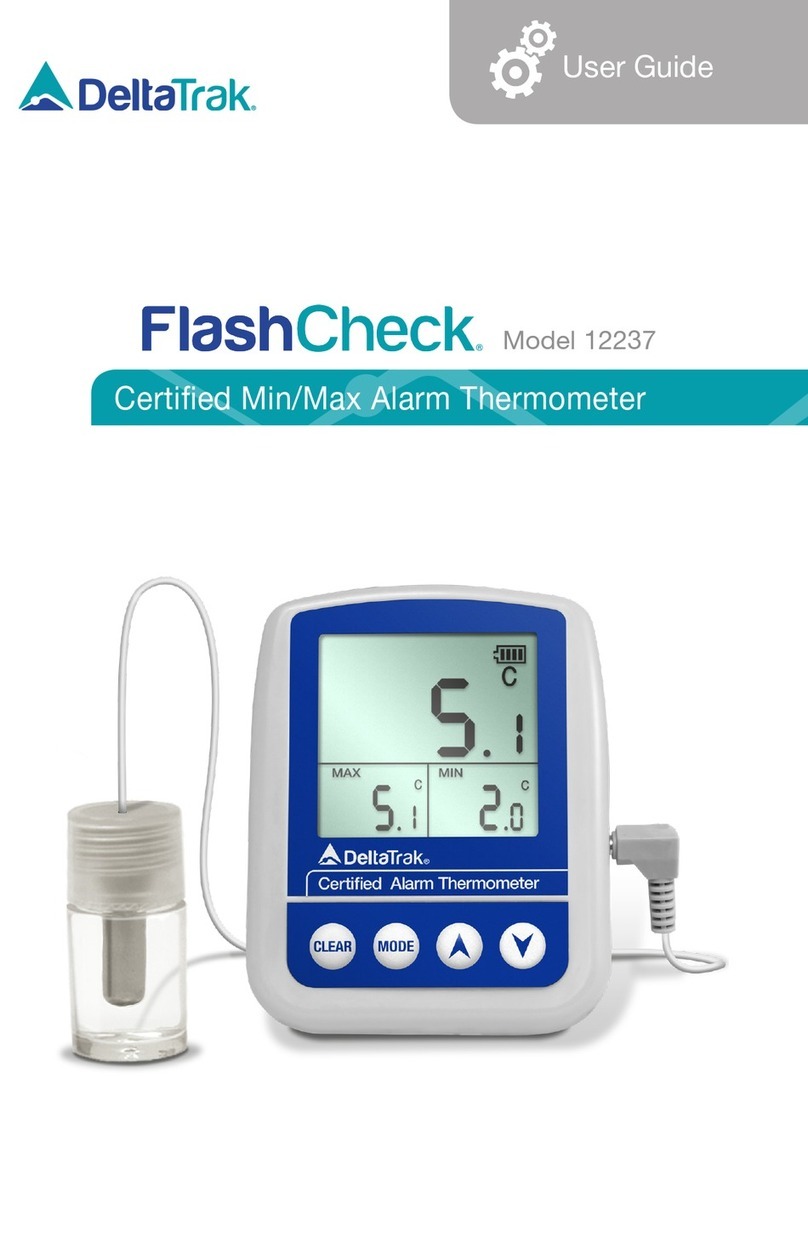
DeltaTRAK
DeltaTRAK FlashCheck 12237 User manual
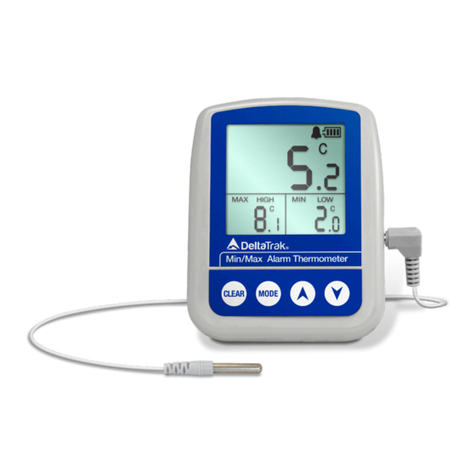
DeltaTRAK
DeltaTRAK FlashCheck 12217 User manual

DeltaTRAK
DeltaTRAK ThermoTrace 15053 User manual
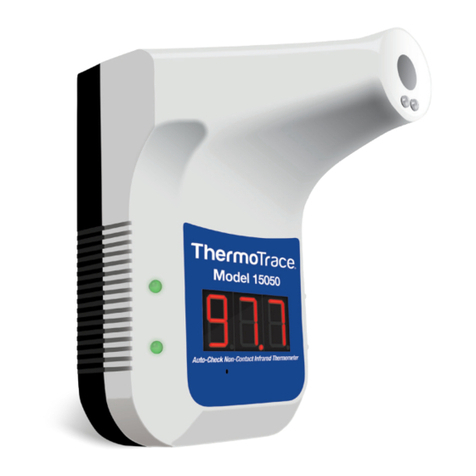
DeltaTRAK
DeltaTRAK ThermoTrace 15050 User manual
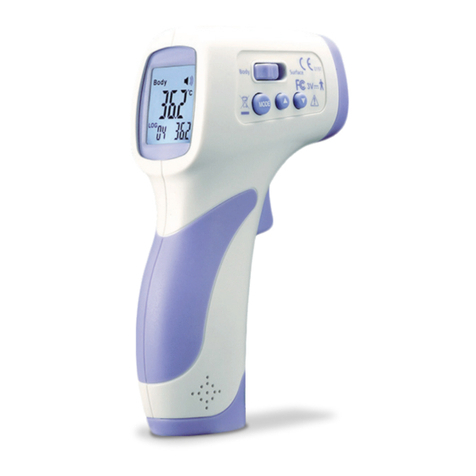
DeltaTRAK
DeltaTRAK DT-8806H User manual
